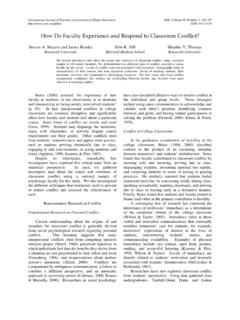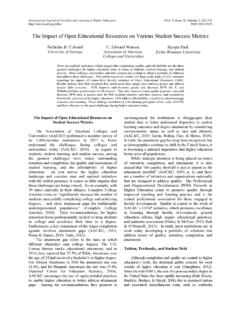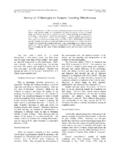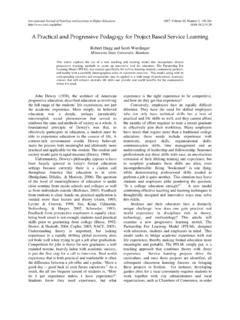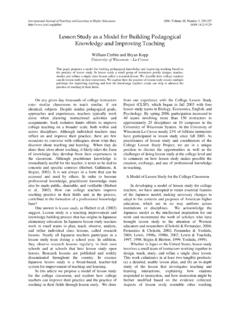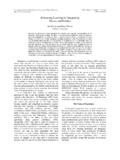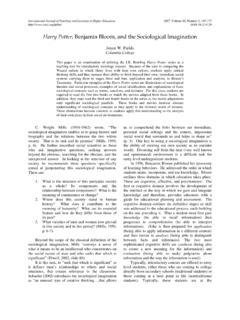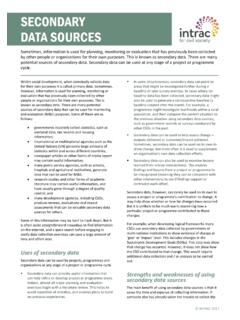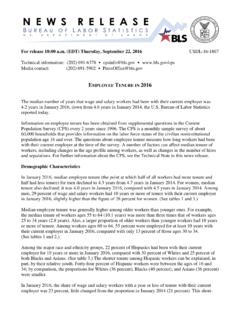Transcription of Survey of 12 Strategies to Measure Teaching Effectiveness
1 International Journal of Teaching and Learning in Higher Education 2005, Volume 17, Number 1, 48-62. ISSN 1812-9129. Survey of 12 Strategies to Measure Teaching Effectiveness Ronald A. Berk Johns Hopkins University, USA. Twelve potential sources of evidence to Measure Teaching Effectiveness are critically reviewed: (a). student ratings, (b) peer ratings, (c) self- evaluation , (d) videos, (e) student interviews, (f) alumni ratings, (g) employer ratings, (h) administrator ratings, (i) Teaching scholarship, (j) Teaching awards, (k) learning outcome measures, and (l) Teaching portfolios. National standards are presented to guide the definition and measurement of effective Teaching . A unified conceptualization of Teaching Effectiveness is proposed to use multiple sources of evidence, such as student ratings, peer ratings, and self- evaluation , to provide an accurate and reliable base for formative and summative decisions. Multiple sources build on the strengths of all sources, while compensating for the weaknesses in any single source.
2 This triangulation of sources is recommended in view of the complexity of measuring the act of Teaching and the variety of direct and indirect sources and tools used to produce the evidence. Yup, that's what I typed: 12. A virtual the measurement tools, the technical analysis of the smorgasbord of data sources awaits you. How many results, and the reporting and interpretation of the can you name other than student ratings? How many evidence for decision making. are currently being used in your department? That's The Standards address WHAT is measured and what I thought. This is your lucky page. By the time then HOW to Measure it: WHAT The content of any you finish this article, your toughest decision will be tool, such as a student or peer rating scale, requires a (Are you ready? Isn't this exciting?): Should I slog thorough and explicit definition of the knowledge, through the other IJTLHE articles? WROOONG! It's: skills, and abilities (KSAs), and other characteristics Which sources should I use?
3 And behaviors that describe the job of effective Teaching (see Standards ). HOW The data Teaching Effectiveness : Defining the Construct from a rating scale or other tool that is based on the systematic collection of opinions or decisions by raters, Why is measuring Teaching Effectiveness so observers, or judges hinge on their expertise, important? Because the evidence produced is used for qualifications, and experience (see Standard ). major decisions about our future in academe. There are Student and peer direct observations of WHAT. two types of decisions: formative, which uses the they see in the classroom furnish the foundation for evidence to improve and shape the quality of our their ratings. However, other sources, such as student Teaching , and summative, which uses the evidence to outcome data and publications on innovative Teaching sum up our overall performance or status to decide Strategies , are indirect, from which Teaching about our annual merit pay, promotion, and tenure.
4 The Effectiveness is inferred. These different data sources former involves decisions to improve Teaching ; the vary considerably in how they Measure the WHAT. latter consists of personnel decisions. As faculty, we We need to be able to carefully discriminate among all make formative decisions to plan and revise our available sources. Teaching semester after semester. Summative decisions are final and they are rendered by administrators or Beyond Student Ratings colleagues at different points in time to determine whether we have a future. These decisions have an Historically, student ratings have dominated as the impact on the quality of our professional life. The primary Measure of Teaching Effectiveness for the past various sources of evidence for Teaching Effectiveness 30 years (Seldin, 1999a). However, over the past may be employed for either formative or summative decade there has been a trend toward augmenting those decisions or both. ratings with other data sources of Teaching performance.
5 Such sources can serve to broaden and deepen the National Standards evidence base used to evaluate courses and assess the quality of Teaching (Arreola, 2000; Braskamp & Ory, There are national standards for how Teaching 1994; Knapper & Cranton, 2001; Seldin & Associates, Effectiveness or performance should be measured the 1999). Standards for Educational and Psychological Testing Several comprehensive models of faculty (AERA, APA, & NCME Joint Committee on evaluation have been proposed (Arreola, 2000;. Standards, 1999). They can guide the development of Braskamp & Ory, 1994; Centra, 1999; Keig &. Berk Strategies to Measure Teaching Effectiveness 49. Waggoner, 1994; Romberg, 1985; Soderberg, 1986). dimensions: (a) gathering data and (b) using that data They include multiple sources of evidence with greater for judgment and decision making with respect to weight attached to student and peer input and less agreed-upon standards. Measurement tools are needed weight attached to self- evaluation , alumni, to collect that data , such as tests, scales, and administrators, and others.
6 All of these models are used questionnaires. The criteria for Teaching Effectiveness to arrive at formative and summative decisions. are embedded in the content of these measures. The most common measures used for collecting the data for A Unified Conceptualization faculty evaluation are rating scales. I propose a unified conceptualization of Teaching 12 Sources of Evidence Effectiveness , whereby evidence is collected from a variety of sources to define the construct and to make There are 12 potential sources of evidence of decisions about its attainment. Much has been written Teaching Effectiveness : (a) student ratings, (b) peer about the merits and shortcomings of the various ratings, (c) self- evaluation , (d) videos, (e) student sources of evidence currently being employed. Each interviews, (f) alumni ratings, (g) employer ratings, (h). source can supply unique information, but also is administrator ratings, (i) Teaching scholarship, (j). fallible, usually in a way different from the other Teaching awards, (k) learning outcome measures, and (l).
7 Sources. For example, the unreliability or biases of peer Teaching portfolio. An outline of these sources is ratings are not the same as those of student ratings; shown in Table 1 along with several salient student ratings have other weaknesses. By drawing on characteristics: type of Measure needed to gather the three or more different sources of evidence, the evidence, the person(s) responsible for providing the strengths of each source can compensate for evidence (students, peers, instructor, or administrator), weaknesses of the other sources, thereby converging on the person or committee who uses the evidence, and the a decision about Teaching Effectiveness that is more decision(s) typically rendered based on that data (F =. accurate than one based on any single source (Appling, formative/ S = summative/ P = program). The purpose Naumann, & Berk, 2001). This notion of triangulation of this article is to critically examine the value of these is derived from a compensatory model of decision 12 sources reported in the literature on faculty making.
8 Given the complexity of measuring the act of evaluation and to deduce a bottom line . Teaching , it is reasonable to expect that multiple sources recommendation for each source based on the current can provide a more accurate, reliable, and state of research and practice. comprehensive picture of Teaching Effectiveness than just one source. However, the decision maker should Student Ratings integrate the information from only those sources for which validity evidence is available (see Standard The mere mention of faculty evaluation to many ). college professors conjures up mental images of the According to Scriven (1991), evaluation is the shower scene from Psycho. They're thinking: Why process, whose duty is the systematic and objective not just whack me now, rather than wait to see those determination of merit, worth, or value. Without such a student ratings again. Student ratings have become process, there is no way to distinguish the worthwhile synonymous with faculty evaluation in the United from the worthless.
9 (p. 4) This process involves two States (Seldin, 1999a). TABLE 1. Salient Characteristics of 12 Sources of Evidence of Teaching Effectiveness Source of Evidence Type of Measure (s) Who Provides Evidence Who Uses Evidence Type of Decision1. Student Ratings Rating Scale Students Instructors/Administrators F/S/P. Peer Ratings Rating Scale Peers Instructors F/S. Self- evaluation Rating Scale Instructors Instructors/Administrators F/S. Videos Rating Scale Instructors/Peers Instructors/Peers F/S. Student Interviews Questionnaires Students Instructors/Administrators F/S. Alumni Ratings Rating Scale Graduates Instructors/Administrators F/S/P. Employer Ratings Rating Scale Graduates' Employers Instructors/Administrators P. Administrator Ratings Rating Scale Administrators Administrators S. Teaching Scholarship Judgmental Review Instructors Administrators S. Teaching Awards Judgmental Review Instructors Faculty Committees/Administrators S. Learning Outcomes Tests, Projects, Simulations Students Instructors/Curriculum Committees F/P.
10 Teaching Portfolio Most of the above Instructors, Students, Peers Promotions Committees S. 1. F = formative, S = summative, P = program Berk Strategies to Measure Teaching Effectiveness 50. It is the most influential Measure of performance However, before you grab your riot gear, you might used in promotion and tenure decisions at institutions want to consider 11 other sources of evidence. End of that emphasize Teaching Effectiveness (Emery, Kramer, Digression]. & Tian, 2003). Recent estimates indicate 88% of all liberal arts colleges use student ratings for summative BOTTOM LINE: Student ratings is a necessary source decisions (Seldin, 1999a). A Survey of 40,000 of evidence of Teaching Effectiveness for both formative department chairs (US Department of Education, 1991) and summative decisions, but not a sufficient source for indicated that 97% used student evaluations to assess the latter. Considering all of the polemics over its Teaching performance.
